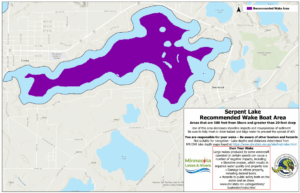Alum Treatments/Purple Loosestrife/No Wakes
Alum Treatments to Control Phosphorus in Lakes
What is alum and how does it work? ALUM (aluminum sulfate) is a nontoxic material commonly used in water treatment plants to clarify drinking water. In lakes, alum is used to reduce the amount of the nutrient phosphorus in the water. Reducing phosphorus concentrations in lake water can have a similar clarifying effect by limiting the availability of this nutrient for algae production. Phosphorus enters the water either externally, from run-off or groundwater, or internally, from the nutrient rich sediments on the bottom of the lake. Phosphorus is released from the sediments under anoxic conditions that occur when the lake stratifies and oxygen is depleted from the lower layer. Even when external sources of phosphorus have been curtailed by best management practices, the internal recycling of phosphorus can continue to support explosive algal growth. Alum is used primarily to control this internal recycling of phosphorus from the sediments of the lake bottom. On contact with water, alum forms a fluffy aluminum hydroxide precipitate called floc. Aluminum hydroxide (the principle ingredient in common antacids such as Maalox) binds with phosphorus to form an aluminum phosphate compound. This compound is insoluble in water under most conditions so the phosphorus in it can no longer be used as food by algae organisms. As the floc slowly settles, some phosphorus is removed from the water. The floc also tends to collect suspended particles in the water and carry them down to the bottom, leaving the lake noticeably clearer. On the bottom of the lake the floc forms a layer that acts as a phosphorus barrier by combining with phosphorus as it is released from the sediments. Why treat a lake with alum? Increased nutrient loading, particularly phosphorus, has accelerated eutrophication of lakes and consequently reduced their ecological health and recreational value. Frequent and pervasive algal blooms, low water transparency, noxious odors, depletion of dissolved oxygen, and fish kills frequently accompany cultural eutrophication. External sources of phosphorus delivered in run-off from the watershed are often the main contributor of excessive phosphorus to lakes.
[Article from Wisconsin Department of Natural Resources]
The water in Cranberry Lake was treated with Alum on June 6th. The objective is to reduce the amount of phosphorus from Cranberry that flows into Serpent. Flow measurements indicate 57 pounds of phosphorus flows into Serpent each year. This predicts an additional 28,500 pounds of plant life in Serpent, mostly Algae. Algae is the major contributor to reduced water clarity in Serpent Lake. Cranberry Lake’s phosphorus concentration in the water column was 155 mcg/L on June 2nd (before treatment). After treatment on June 15th, the concentration was 39 mcg/L. The treatment Alum combined with 75% of the available phosphorus. This newly formed inorganic compound is dense so it precipitated. The new compound is similar to clay soil found on many lake bottoms. Without motor boat traffic on Cranberry and a lack of high waves from the wind, the thin layer of precipitate should remain in place longer. We are planning on water testing Cranberry in the coming years to see if, or how fast, the lake returns to its former state. Typical MN lakes, most a lot larger, than Cranberry, have taken up to 15 years before treatment was needed again.
Now is the time to check your shoreline for Purple Loosestrife
Those pretty purple flowers on a stem along your shoreline could be an invasive plant. The following shows the leave arrangement, stem geometry, and flower peddles that make it easy to ID Purple Loosestrife. With all the rain we had recently, the stems are easily pulled out.
High Water – No Wake Zone
After all of the storms and rain we received in July, many lakes in our area declared a no wake zone on their lakes. This was to prevent erosion of lakeshore and further damage to docks and watercraft. Our Lake level is still very high and we are asking all boat and watercraft operators to be responsible and not operate close to shore and avoid creating large wakes from your watercraft. We have all had too much damage from the storms, so please be courteous toward your neighbors on the lake.


